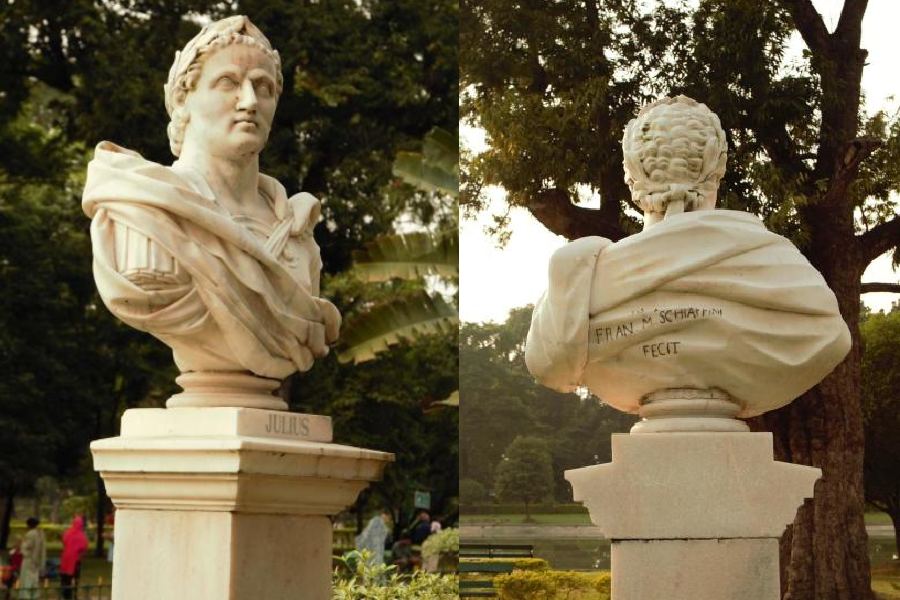The Twelve Caesars, a series of marble busts of the first 12 Roman rulers, have moved from obscurity and privileged space of Raj Bhavan to the more democratic and open surroundings of the Southern Lawns of the Victoria Memorial Hall.
While the origins of the white marble busts of the first 12 Roman emperors are yet to be firmly established, the name of Francesca Maria Schiaffino engraved on the back of the busts, made Chiara Rostagno, visiting architect and professor of Enhancement of Fragile Cultural Heritage, Milan, claim they were from Genoa in northern Italy, where the sculptor’s workplace and studio was.
However, to establish firmly the origins of the heads, Rostagno said she would ask the bishop of Genoa to send a copy of Schiaffino’s signature that can be found in the sculptor’s other works in Genoa.
Speaker Sujaan Mukherjee introduced the newly moved statues as part of the Italo-Kolkatan Heritage Conversation Series: The Enigma of the Emperors, held at the lawns of the Victoria Memorial Hall on Wednesday afternoon.
“I saw these 12 marble statues here a year back. They blended in so well with the surroundings that one would hardly notice them. The first recorded mention of them was at the Governor’s House, or Raj Bhavan as it is known today, and what intrigued me was that in my knowledge this was the first time it was in public view and you could actually see the rear side of the statue where the name is inscribed,” said Mukherjee, sparking a conversation on how the statues came to be in Kolkata.
The other speakers included Rostagno and Sukanta Chaudhuri, professor emeritus, Jadavpur University. The Italian consul general in Kolkata, Gianluca Rubagotti, and the Victoria Memorial director, Samarendra Kumar, were in attendance.
There are multiple theories doing the rounds on how these busts came to India. One was that Napoleon sent them to the Nizam of Hyderabad or Tipu Sultan, and from there they came into the hands of the British.
Another theory says they were at the Chandernagore Court and in 1756, when Clive and Watson laid siege to the city, those were captured and added to the Raj Bhavan adornments. Lord Curzon, however, refutes all of these and claims they were ordered by Lord Wellesley for the Governor’s House.
Even though the sculptures have Schiaffino’s name inscribed, researcher Mukherjee pointed out that the sculptor was dead by the time the Governor’s House came into being.
“Schiaffino passed away in 1763 and the Governor’s House was made in 1803. So was it his studio which created these?” asked Mukherjee.
“Now we are looking at the possibility that these were sculpted by Schiaffino himself, as opposed to his studio, posthumously. There is a name inscribed but still, there is doubt. We are looking at histories of Italian art, whether from the biographies of Schiaffino do we know whether he accepted these commissions?”
Rostagno, former director of Museo Nazionale del Cenacolo Vinciano (The Last Supper Museum) and team leader of The Last Supper restoration project, answered emphatically: “For me, this is the right place for the 12 sculptures to stand because they are an expression of classical beauty. I have no doubts regarding who was the artist. These sculptures were made by Schiaffino, of the period 1720-24. Francesco Maria was born in Genoa, a northern city of Italy which was a centre for commerce and business. He came from a family of people who worked on stones. A lot of young artists moved from Genoa to Europe, copying and taking inspiration from Roman and Greek statues. Francesco Maria, too moved. In historical archives, we find that he worked in the studio of Camillo Rusconi, where he spent four years copying important statues of Europe. Young sculptors in those times were copying Michaelangelo and other European sculptures. That is why we have Schiaffino standing in a garden with children here.”
The missing piece here is how they got from Genoa to Governor’s House.
Curzon said his family house in Kedleston Hall in Derbyshire had Twelve
Caesars and they were replicated at Governors House.
Rostagno said the busts were made of carrara marble and marvelled at how the light works on the surface of the sculpture, the air of the imperial rulers and how the sculptor had “given expression to stone”.
Whatever the origins, the fact remains that the lovely statues in stark white are now for the first time in public view. They were relocated from the Raj Bhavan premises to the lawns of the marble monument on the Maidan in April last year.
Chaudhuri, professor emeritus at Jadavpur University, said: “This is just an anecdotal instance of how the material of the Raj is gradually becoming more Indianised and popularised."
He pointed out how from a confined, privileged space the statues were out in a more common space of the Victoria Memorial Hall.
“The statues relate to 2000 years of Roman history, which even at the end of the Raj were in a confined privileged space at the Governor’s House, where something of the Raj still lingers. Now they are out here for the entire public who visits the Victoria Memorial,” he said.
Mukherjee rounded up by saying that the statues as they are placed currently look ornamental, like some bric-a-brac at a palace. “We need a curatorial intervention here with an explanatory note,” he said.
